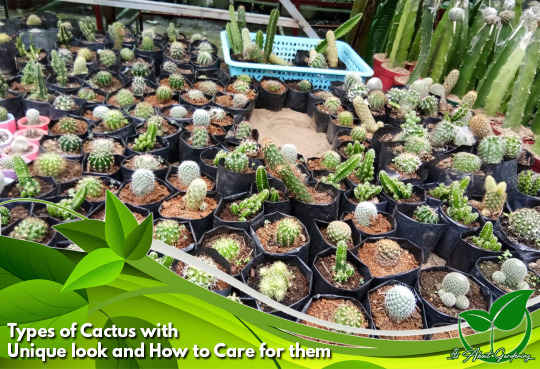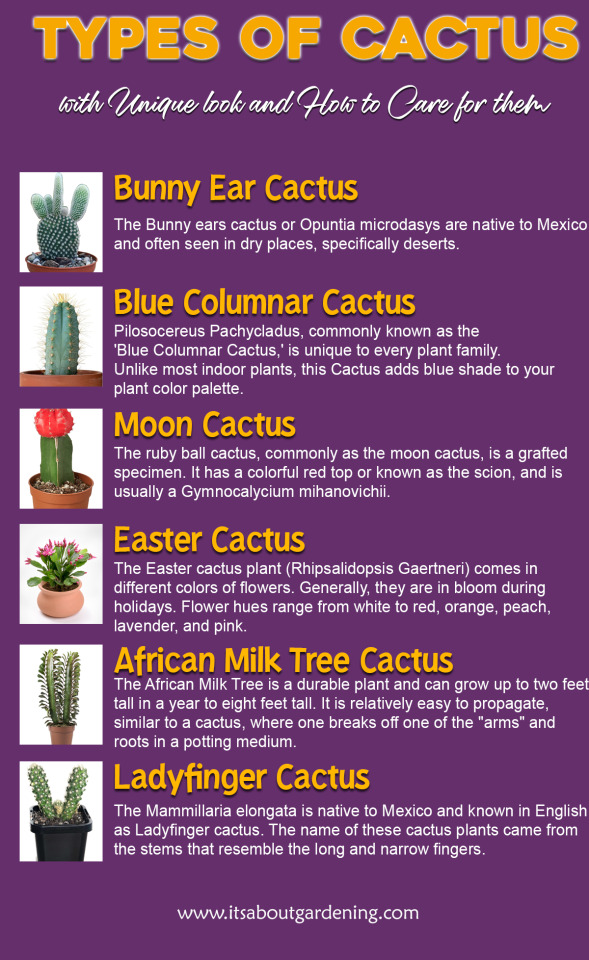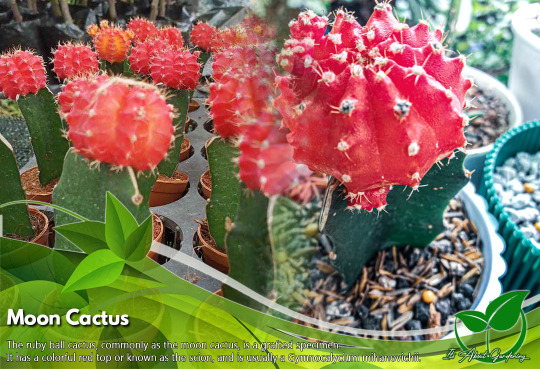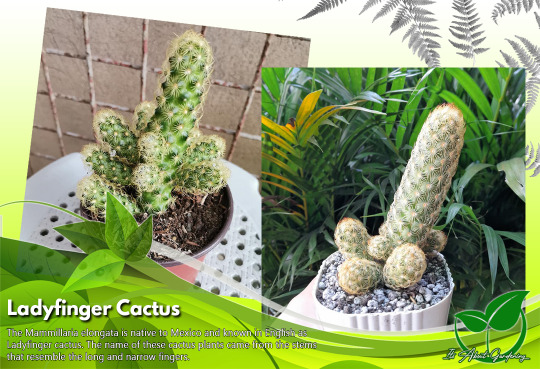#the dirt here is like 70% clay and it is Bright Orange-Red
Explore tagged Tumblr posts
Text
i just realized that you could very believably give a ginger cat the warrior prefix of “mud” if they lived where I do

146 notes
·
View notes
Text
TYPES OF CACTUS WITH UNIQUE LOOK AND HOW TO CARE FOR THEM |itsaboutgardening.com

Types of cactus - Some cactus collectors usually seek sorts of cactus plants with one-of-a-kind looks. Cactus is among one of the most well-known plants nowadays.
Some gardeners like to look after this plant due to the fact that it is not demanding, unlike the other plants that call for a great deal of focus and treatment.

There are many different types of cactus plants and species that garden enthusiasts appreciate due to their special look and do not need a lot of treatment.
Here are some kinds of Cactus as well as some suggestions on exactly how to care for them
Types of Cactus with Unique look and how to Take Care of them

The following cactus kinds possess a special look that will certainly transform your yard or house rooms right into a highlighted and attractive one. As all of us know, cactus are not requiring, so looking after them is a little comfortable with very little interest.
The following are sorts of cactus and some overviews on how to care for them.
Bunny Ear Cactus

The Bunny ears cactus or Opuntia microdasys are belonging to Mexico and also often seen in completely dry places, especially deserts.
Dealing with bunny ears cactus is very simple because their native homeland is a bare desert. They can survive in a warm climate and also a lot of direct exposure to the sunlight.
The bunny ears cactus plants might be the ideal plant for you considering that it doesn't require much attention as well as mainly undemanding.
Bunny Ears Cactus Care
Handling. Use thick rubber gloves or utilized newspaper in touching up the pad of the rabbit ears cactus. Dry the cut section for three days before replanting it on a cactus soil mix.
Soil. Make use of an outstanding cactus mix for growing rabbit ears cactus, or you can make your mix.
Watering. These plants are a garden enthusiast's pick for their low maintenance as well as appealing look. However, overwatering this plant may cause the plant's fatality. Interval watering, or watering when the topsoil is dry, is suggested.
Food. You can provide fertilizer to your bunny ears Cactus every summer season or spring to keep your plant healthy.
pests. These Cactus kinds are prone to troubles like mealybugs and also scale insects, particularly on the cacti's pad. Protect against these bugs from ruining plants by using a fungicide. Other gardeners scrub alcohol on the plant to get rid of the troubles.
Repotting: The bunny ears don't require continuous repotting. When every year suffices given that this plant is a slow-growing type of cactus.
Blue Columnar Cactus

Pilosocereus Pachycladus, typically called the 'Blue Columnar Cactus,' is one-of-a-kind to every plant family. Unlike the majority of indoor plants, this Cactus adds blue color to your plant color palette.
The plant's color as well as natural, soft-grey coating contrasts the Cactus spikes, appropriate artwork by the environment.
Blue Columnar Cactus Care
Light: Like the other cacti, they require lots of straight sunshine to flourish.
Water: They need a steady water system during the summertime and also prevent overwatering them, which can cause root rot.
Temperature: Blue columnar Cactus favors hot exotic temperature levels, ideally around or over 70 levels Celcius.
Soil: This Cactus chooses completely dry soil with some natural nutrients, as well as excellent drain is crucial.
Moon Cactus

The ruby round cactus, frequently as the moon cactus, is an implanted sampling. It has a vibrant red top or referred to as the successor, and also is normally a Gymnocalycium mihanovichii.
The rootstock in the moon cactus can be several ranges of cactus plants, yet generally, some gardeners use dragon fruit because of its tough body.
Moon Cactus Care
Light: The heir likes color and also does not such as straight sunshine. Nonetheless, the rootstock prefers sunshine, unlike the successor. Putting them in a bright location is recommended.
Soil: Moon cactus prefers rich and quick-draining dirt combines with a reduced pH. See to it to utilize dirt loaded with great deals of nutrients to keep the rootstock healthy and balanced.
Water: Make certain that the soil becomes completely dry prior to sprinkling your moon cactus once again. Avoid soaking it in wet soil for more than a day due to the fact that it may trigger rot. The moon cactus plant requires adequate watering, specifically throughout the summertime. During the winter season, water them consistently is not needed. Misting them every now and then is okay.
Fertilizer: The moon cactus doesn't require plant foods consistently, yet during its expanding season, you should provide a cactus plant food to keep them healthy and balanced.
Repotting: Repot your moon cactus as often as feasible, ideally during the summer season. When repotting a cactus, maintain the dirt dry before repotting and remove it from its pot carefully to avoid root devastation. Remove the old dirt, seek pest check in the origins, and then cut the dead roots from the Cactus If tiny pests are prowling on the plant's roots, wash them meticulously in running water. Usage fungicide in treating the cuts. Position the plant and thoroughly position it in a pot as well as fill potting soil mix planned for cactus plants. Avoid watering the freshly potted plant in a week to prevent origin rot.
Easter Cactus

The Easter cactus plant (Rhipsalidopsis Gaertneri) is available in different shades of blossoms. Generally, they remain in bloom during vacations. Flower shades vary from white to red, orange, peach, lavender, as well as pink.
Easter Cactus Care
Watering: Offer your Easter cactus a good pour of water & allow all of it drainpipe extensively out of its pot. Make certain the plant goes completely dry prior to watering it again.
Light: Easter cactus prefer intense all-natural light without any direct light from the sunlight. Straight sunlight will burn the fleshy fallen leaves of a Spring Cactus
Soil: Easter cactus expand on other plants, rocks & bark in their native environments. They do not grow in soil. In nature, they feed off fallen leave matter & debris, which means they like an extremely permeable blend with some richness.
Fertilizing: Wait up until 1-2 months after your Springtime Cactus has completed its bloom to fertilize. You want it to relax before striking it with the great things.
African Milk Tree Cactus

The African Milk Tree Cactus is a sturdy plant as well as can grow up to two feet high in a year to 8 feet tall.
It is reasonably simple to propagate, similar to a cactus, where one breaks off one of the "arms" and also roots in a potting tool.
African Milk Tree Cactus Care
Light: This sort of cactus plant chooses indirect yet intense sunlight. Nevertheless, it can additionally deal with full sunlight direct exposure as long as the summertime's are not too consistently warm.
Soil: This type of Cactus is not as well precise about dirt mixes, but good drain can make your cactus healthy. Heavy clay soil might limit growth and impede drain.
Water: The African milk tree does not require much water. If there is a terrible dry spell, consider supplemental watering at the origins. Yet otherwise, average rainfall should suffice.
Temperature and Humidity: This drought-tolerant plant prefers a dry or dry climate and can tolerate warm temperatures. If grown in an area with scorching summers, the plant ought to be put in a place with partial color to avoid overheating.
Ladyfinger Cactus

The Mammillaria elongata is native to Mexico as well as recognized in English as Ladyfinger cactus. The name of these cactus plants came from the stems that resemble the long and also narrow fingers.
They expand from the center and also obtain even more vast and spilling as it expands longer. The ladyfinger is an outstanding option for gardens that require a slow-spreading plant, a small container, or a hanging pot.
Ladyfinger Cactus Care Guide
Light: If you are going to placed it outdoors, make certain the climate is warm and humid like the desert considering that it is native to that sort of environment. Nevertheless, these cactus types can additionally make it through without straight sunshine, gave that they remain in a well-lit area.
Watering: The ladyfinger cactus can endure dry spell, just like the majority of Cactus types however make certain they obtain enough water occasionally. However, prevent overwatering them since it might trigger root rot.
Temperature and Humidity: The ladyfinger cactus requires a container brought particularly for indoors. See to it the area is well-ventilated and a bright area where it can indirectly receive sunshine.
Soil: This sort of Cactus favors to utilize a common cactus soil mix and also ensure you grow it in a well-draining container or garden bed.
Types of cactus plants with unique looks and how to care for them - The adhering to cactus types pointed out above are a terrific enhancement to your garden, and they all possess an unique appearance.
Do you understand that they likewise have the one-of-a-kind capability to take in damaging chemicals released by our gadgets or what we call radiation?
Consequently, we can add them to our outdoor garden and also in our residence areas.
#TYPES OF CACTUS#Bunny Ear Cactus#Blue Columnar Cactus#Moon Cactus#Easter Cactus#African Milk Tree Cactus#Ladyfinger Cactus#Cactus Care
1 note
·
View note